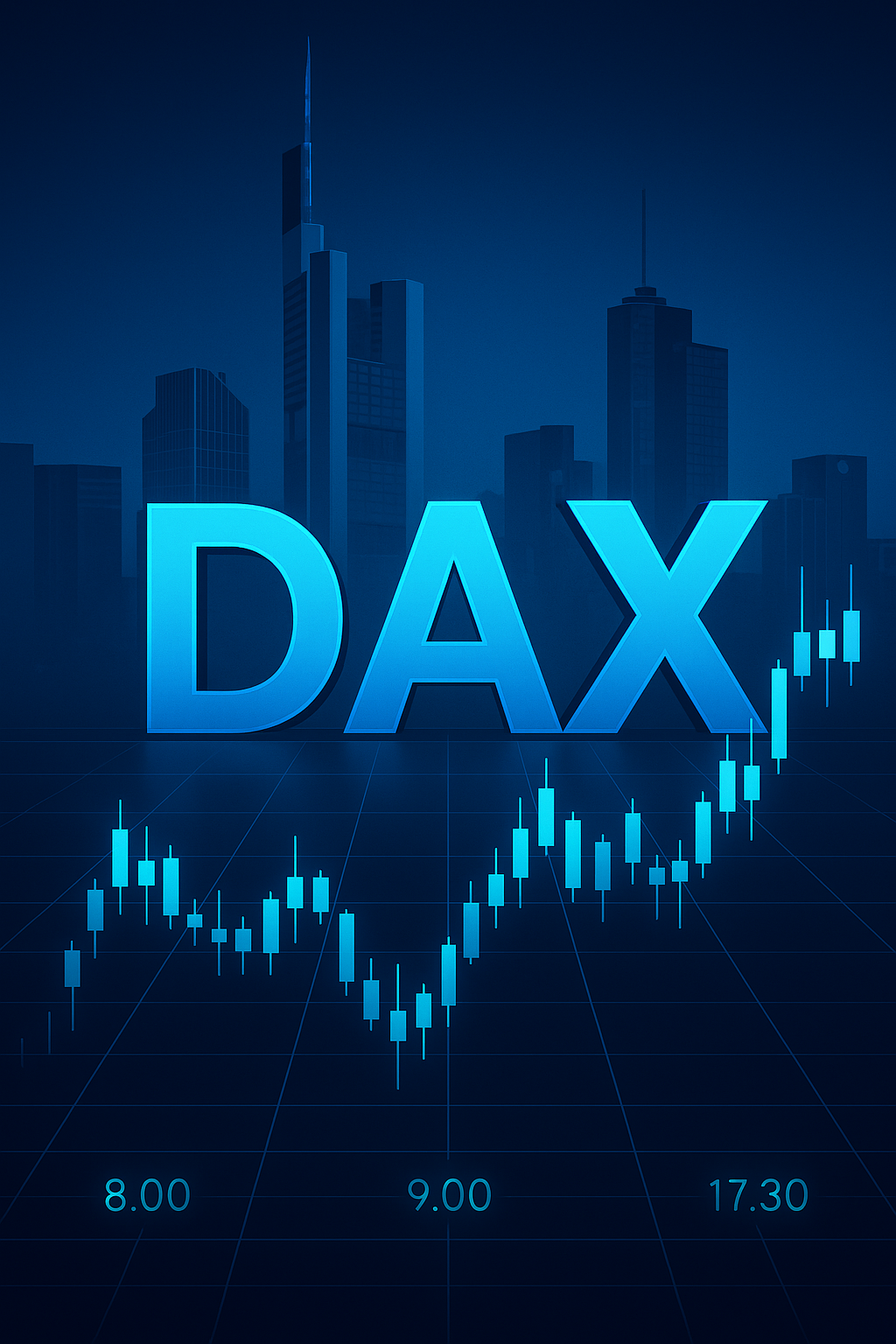Understanding The DAX Index
Index Composition And Weightings
The DAX (Deutscher Aktienindex) is Germany’s blue-chip index with the 40 largest and most liquid stocks listed on the Frankfurt Stock Exchange. Administratively there is a who-is-who in the German industry: automotive giants such as Volkswagen and Mercedes-Benz, engineering colossus Siemens and Bosch, chemical powerhouses Bayer and BASF, and big-name financiers, Deutsche Bank and Allianz. Weight of a company in the index is by free-float market capitalization; only shares which are freely tradable contribute toward its calculation. Contrary to a pure market-cap index, there is a capping factor applied in DAX so that domination by one firm is avoided: no constituent shall have more than 10 percent weight at rebalance, in order to ensure balanced exposure.
Trading Hours And Market Calendar
Primary trading occurs on the XETRA electronic platform, which opens with an auction from 8:00 to 9:00 CET, continues with continuous trading from 9:00 until about 17:30 CET, and then finishes with another closing auction. There is a very small trading volume that takes place under book-building at the Frankfurt floor between 9:00 and 17:30 CET, with slightly wider spreads, block trades, and the like.
Key calendar considerations:
-
European holidays (Good Friday, Easter Monday, Christmas Day) shutter XETRA, but some offshore markets may remain open — be cautious of overnight gaps.
-
Early closes on days preceding Easter and Christmas reduce liquidity, often amplifying intraday volatility.
-
U.S.–Europe overlap spans 15:30–17:30 CET; this window sees spikes in volume as U.S. futures and equity desks interact with European order flow, often triggering sharp directional moves tied to S&P 500 or Nasdaq futures.
Synchronization with macro releases also matters: Germany’s Ifo survey at 10:00 CET, Eurozone CPI at 11:00 CET, and U.S. jobs data at 14:30 CET can create rapid price swings within the trading day.
Ways To Trade The DAX

Futures Contracts
Eurex’s FDAX futures are the workhorse for professional traders. One contract equals €25 × index level (e.g., a DAX at 15,000 equates to €375,000 notional). Tick size is 0.5 points (€12.50), and quarterly expiry months (March, June, September, December) anchor the term structure. In addition to standard contracts, mini‑DAX (ticker: FDXM) at €5 × index offers smaller account traders access with proportionally reduced risk.
Hedgers use FDAX to lock in EUR exposure for German equity portfolios, while speculators deploy machine‑driven scalping strategies in milliseconds. Margin rates vary by broker but typically require 5–10 percent. Traders must manage basis risk when rolling positions: as the front‑month approaches expiry, liquidity migrates to the next contract, often creating slight price dislocations.
DAX ETFs And ETNs
Popular UCITS ETFs include:
-
iShares Core DAX UCITS ETF (DE) at 0.16 percent total expense ratio (TER).
-
Xtrackers DAX UCITS ETF with physical replication, distributing dividends quarterly.
-
Lyxor DAX Daily (2x) Leveraged ETN for amplified returns — risky but useful for short‑term tactical bets.
ETFs physically hold baskets of shares; ETNs synthetically replicate via swaps, exposing investors to issuer credit risk. Domicile and tax treatment matter: a Germany‑domiciled ETF may incur lower withholding on dividends (15 percent) than an Ireland‑domiciled one (30 percent), affecting net returns for non‑German investors.
CFDs And Spread Bets
CFDs offered by retail brokers allow margin as high as 1:30 (depending on ESMA rules and account classification). Traders speculate on price differences without owning the underlying. Overnight financing rates (swap) can range from 1.5–2.5 percent above EURIBOR, so holding trades for multiple days incurs costs. Spread betting (for U.K./Irish clients) enjoys tax‑free gains but shares similar overnight charges. Both instruments require robust risk controls due to potential for rapid margin calls during events like ECB announcements.
Individual DAX Shares
Building a custom mini‑DAX portfolio involves purchasing each constituent based on target weights and rebalancing quarterly. This hands‑on approach eliminates product fees but requires larger capital outlay and trading commissions. Traders must track corporate actions — mergers, spin‑offs, stock splits — and reallocate capital accordingly. A typical approach is equal‑value weighting: for a €100,000 portfolio, invest €2,500 in each of 40 stocks, then adjust after large price moves to maintain balance.
Setting Up Your DAX Trading Account
Choosing A Broker
When selecting a broker:
-
Regulation: Look for FCA, BaFin or CySEC oversight.
-
Execution Quality: Examine slippage reports and fill rates.
-
Clearing Access: Tier 1 clearing reduces counterparty exposure.
-
Latency: Proximity hosting in Frankfurt can shave milliseconds for HFT.
-
Fee Structure: Flat commission vs. spread‑only models — compare all‑in costs.
Account Types And Leverage Options
-
Standard Retail: Leverage capped at 1:10 per ESMA; negative balance protection mandated.
-
Professional: Requires demonstration of significant trading activity or portfolio size; offers up to 1:30 leverage, no negative balance protection.
-
Institutional: Custom pricing, direct clearing, tailored risk limits; suitable for funds and proprietary desks.
Funding in EUR avoids currency conversion fees; multi‑currency accounts can hold GBP or USD but may impact margin calculations.
Platform Features And Tools
A comprehensive platform should offer:
-
Market Depth: Top 5 and full order book visibility for XETRA; critical for anticipating liquidity pockets.
-
Advanced Order Types: OCO (one‑cancels‑other), iceberg orders for large block trades, stop‑limit and trailing stops.
-
Integrated Newsfeed: Direct Reuters or Bloomberg headlines synced with order entry.
-
Charting & Backtesting: On‑platform scripting (e.g., TradingView Pine) to test strategies on historical DAX data.
-
API Access: FIX or REST APIs for algorithmic execution and real‑time monitoring.
-
Mobile/Web Apps: Mirror desktop functionality to monitor positions on the go, with two‑factor authentication for security.
Key Factors Influencing DAX Movements
German Economic Indicators
-
Ifo Business Climate: A leading sentiment gauge, 1 percent surprise can move DAX by ~100 points intraday.
-
ZEW Economic Sentiment: Reflects investor outlook; swings of ±15 points often correlate with 0.5 percent index moves.
-
GDP Releases: Quarterly growth above/below consensus (e.g., 0.3 percent QoQ vs. 0.1 percent) drives sector rotation.
-
Unemployment Rate: A decline from 5 percent to 4.8 percent can spur bank and consumer discretionary shares.
Eurozone Monetary Policy
ECB’s deposit rate changes ripple through bond yields and cross‑asset flows. A 25 bp hike in deposit rate typically strengthens the euro, pressuring exporters, while boosting financials on higher net interest margins. QE tapering announcements can trigger equity sell‑offs of 2–3 percent in short‑term bouts.
Corporate Earnings And Sector Trends
Seasonal earnings cadence: tech names (SAP, Infineon) report earlier in Q4, while auto (VW, BMW) release later. Margin guidance is critical—if semiconductor shortages ease, we see upgrades in industrial stocks. Watch sectoral divergences: healthcare often outperforms during recessions, buffering index declines.
Global Macro And Geopolitical Events
Trade disputes between U.S. and China affect German exporters heavily; a 10 percent tariff can erase €5 billion in annual profits for automotive giants. Energy price shocks—like a sudden 20 percent rise in natural gas—hit chemicals and utilities, dragging the DAX. Brexit developments still matter for banks like Commerzbank with U.K. exposure.
Proven Trading Strategies For The DAX
Trend‑Following Techniques
Combine 20‑ and 50‑day exponential moving averages: a crossover above signals entry; a reverse crossover signals exit. Filter with the ADX indicator—only trade when ADX > 25. Use position pyramiding: add to winners at predefined intervals (e.g., every 50 points move) while adjusting stops to breakeven.
Range Trading And Mean Reversion
Identify sideways markets via Average True Range below 1 percent of index level. Use Bollinger Bands (20, ±2σ) to buy near lower band and sell near upper band. Place stops just outside bands to minimize false breakout losses. This tactic suits low‑volatility days lacking major news catalysts.
Breakout And Momentum Strategies
Track accumulation patterns via VWAP anchored at major support levels. A close above VWAP with volume 1.5× average signals a potential breakout. Supplement with RSI—enter long when RSI breaks above 60 in an uptrend, exit when it dips below 50. Favor breakouts post‑ECB rate announcements when volatility is elevated.
Seasonal And Calendar Effects
Study historical seasonality:
-
January Effect: Small uptick in January often boosts tech‑adjacent DAX components.
-
Easter Rally: Post‑Easter week offers short squeeze opportunities.
-
Pre‑Holiday Lull: Late November experiences lower volume; avoid large positions due to thinning liquidity.
Overlay these patterns with fundamental triggers for higher confidence—e.g., pairing “Santa Claus rally” with corporate buyback announcements.
Risk Management And Position Sizing
Stop‑Loss And Take‑Profit Guidelines
Calculate volatility‑based stops: 1.5 × 14‑day ATR (currently ~200 points) yields a 300 point stop for a 15,000 DAX; set profit targets at 600 points for a 1:2 ratio. Use OCO orders to automate exit.
Diversification And Correlation Hedging
Mitigate idiosyncratic risk by pairing DAX exposure with asset classes having low or negative correlation, e.g.:
-
Bund Futures: Short Bunds to hedge equity drawdowns—Bund yields often fall when equities sell off.
-
Gold Futures: Overlay small long gold positions to buffer geopolitical shocks.
Risk‑Reward Ratios And Leverage Control
Implement fixed fractional sizing: risk no more than 1 percent of equity per trade. With €20,000 account, a 300‑point stop at €25 per point equals €7,500 notional; keep position size so that 300 points loss → €200 risk (<1 percent).
Advanced Tools And Technical Indicators
Moving Averages And MACD
MACD histogram divergence—price making higher highs while MACD makes lower highs—signals weakening momentum. Combine with 8‑ and 21‑period SMAs for short‑term trend filters.
RSI And Stochastic Oscillators
RSI failure swings: hold when RSI dips below 30 then rallies above 30—buy signal. Stochastic crossovers in extreme zones (<20 or >80) pinpoint nuanced entry/exit points, especially inside ranges.
VWAP And Market Profile
VWAP indicates fair value for the day; trading above VWAP implies institutional buying. Market Profile structures volume into POCs (points of control) and VAL/HAV zones—trade reversion toward POCs or breakout from value areas.
Algorithmic And Automated Strategies
Develop mean‑reversion bots using Kalman filters to dynamically adjust entry thresholds. Implement time‑weighted average price (TWAP) algorithms for large order execution, slicing orders to minimize market impact.
Building A Robust Trading Plan
Goal Setting And Performance Tracking
Establish SMART goals: Specific (15 percent annual return), Measurable (monthly P&L), Achievable (based on backtested win rate), Relevant (aligned with risk tolerance) and Time‑bound (annual review).
Maintain a trade journal capturing entry rationale, chart snapshots, emotional notes and outcome. Analyze metrics: win rate, average reward/risk, expectancy, drawdown frequency.
Psychology And Discipline
Adopt a ritual: pre‑session meditation, check list (“Three market catalysts for today?”), post‑trade review. Combat FOMO by setting maximum daily loss limits. Use peer accountability or mentorship for behavioral feedback.
Review And Adaptation Process
Quarterly strategy audits: compare historical performance in trending vs. range markets; adjust parameters (e.g., MA lengths, ATR multipliers). Stay abreast of structural changes—like increasing algorithmic volume—or shifts in ECB policy frameworks.
Frequently Asked Questions
What Are The Trading Hours For The DAX?
XETRA’s core session runs 9:00–17:30 CET, bookended by 8:00–9:00 CET opening auctions and 17:30–17:35 CET closing auctions. Frankfurt floor hours mirror these times, and the U.S.–Europe overlap (15:30–17:30 CET) typically sees peak liquidity.
Which DAX ETF Is Best For Beginners?
The iShares Core DAX UCITS ETF (IE00BMBYMK40) is favored for its full physical replication, low TER of 0.16 percent, and robust daily volume. For currency‑hedged exposure, consider the Euro‑hedged share class that minimizes EUR/USD fluctuations.
How Much Leverage Can I Use On The DAX?
Under ESMA, retail clients are limited to 1:10 leverage on DAX CFDs; professional accounts can apply for 1:20–1:30, subject to meeting asset or experience tests. Futures offer higher effective leverage via initial margin (~5–10 percent).
Is Technical Or Fundamental Analysis Better For The DAX?
A hybrid approach works best: use fundamental analysis to gauge macro and sectoral drivers (ECB policy, auto sales) and technical tools (moving averages, VWAP) for precise entries and exits. Fundamentals set the trend; technicals time the trade.
Whether you’re a rookie chart‑reader or a veteran macro‑strategist, the DAX offers fertile ground. Apply these strategies, guard your capital, and let structured discipline guide your profits.

